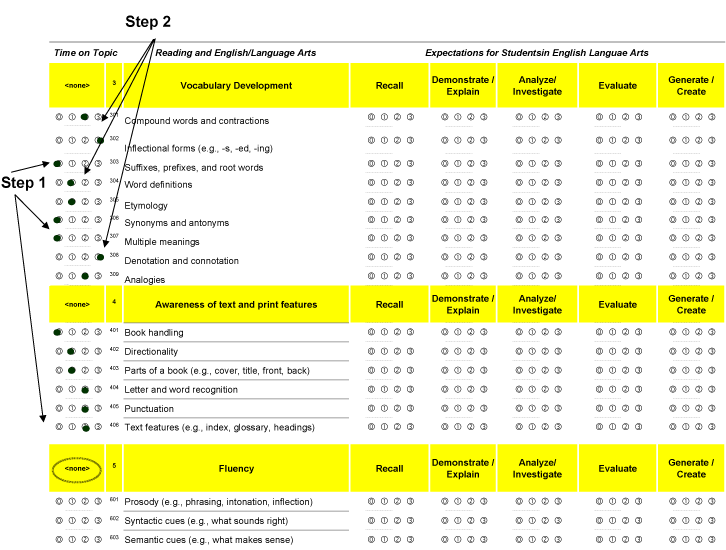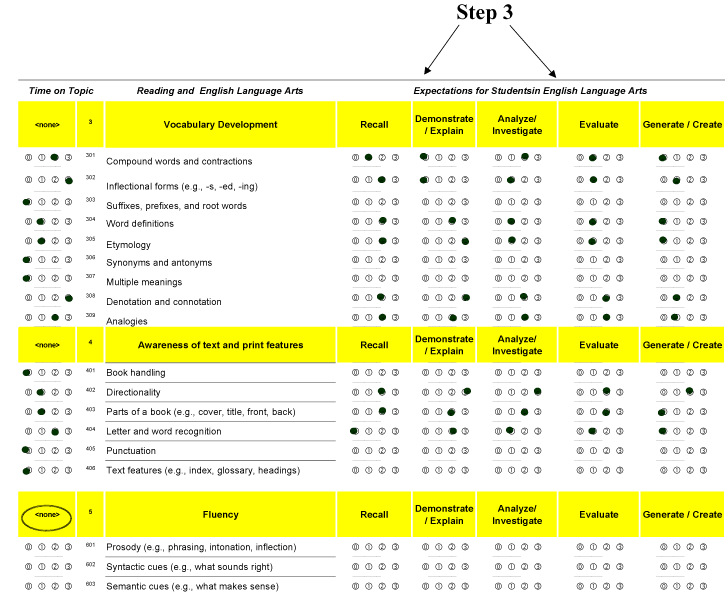Teacher/Faculty Surveys
Instrument 19: Survey of Instructional Content for English Language Arts and Reading
Project: Surveys of Enacted Curriculum
Council of Chief State School Officers
Funding Source: NSF: EHR
Purpose: To gather objective information about the English language arts and reading content that is taught across a wide variety for grade levels and programs
Administered To: K-12 teachers whose school districts are participating in Surveys of Enacted Curriculum project
Topics Covered:
- Implementation Activities: content, method, activities, curriculum/materials, equipment/technology, collaboration, professional development activities
- Learning Environment/Classroom: method, pedagogy
- Lesson/Curriculum Plan: learning environment, methods, content, activities
- Self Assessment (Teacher): application of instructional methods, implementation activities, preparation
Format/Length: 605 closed-ended items
Section II
Survey of Instructional Content
for
English Language Arts and Reading
We now ask for the topics you teach and the expectations you have for student learning in the target reading or language arts class. The next few pages list numerous topics associated with English language arts and reading instruction. The lists were developed to gather objective information about the content that is taught across a wide variety of grade levels and programs. The lists comprehend nearly all topics that experience and research suggest have a place in reading, English language arts, and literature instruction in U.S. classrooms. However, they do not represent recommended or prescribed content and may or may not be reflective of your local curriculum.
Please read the instructions on the next two pages carefully before proceeding.
STEP 1: Indicate topics not covered in this class.
Begin by reviewing the entire list of topics identified in the topics column of
each table, noting how topics are grouped. After reviewing each topic within a given
grouping, if none of the topics listed within that group receive any instructional
coverage, circle the "<none>" in the "Time on Topic" column for that group. For any
individual topic which is not covered in this reading/language arts class, fill-in the circled "zero"
in the "Time on Topic" column. (Not necessary for those groups with "<none>" circled.)
Any topics or topic groups so identified will not require further response.
[Note, for example, that the class described in the example below did not cover
any topics under "Fluency" and so "<none>" is circled.]
STEP 2: Indicate amount of time spent on each topic covered in this class.
Examine the list of topics a second time. This time note the amount of coverage
devoted to each topic by filling in the appropriately numbered circle in the "Time on
Topic" column, based upon the following codes:
| |
0 = None, not covered |
| |
1 = Slight coverage (less than 1 class/lesson) |
| |
2 = Moderate coverage (1 to 5 classes/lessons) |
| |
3 = Sustained coverage (more than 5 classes/lessons) |
STEP 3: Indicate relative emphases of each student expectation for every topic taught.
The final step in completing this section of the survey concerns your
expectations for what students should know and be able to do. For each topic
area, please provide information about the relative amount of instructional time
spent on work designed to help students reach each of the listed expectations by
filling in the appropriately numbered circle using the response codes listed
below. (Note: To the left of each content sheet, you will find a list of descriptors
for each of the five expectations for students.)
| |
0 = No emphasis |
(Not an expectation for this topic) |
| |
1 = Slight emphasis |
(Accounts for less than 25% of the time spent on this topic) |
| |
2 = Moderate emphasis |
(Accounts for 25% to 33% of the time spent on this topic) |
| |
3 = Sustained emphasis |
(Accounts for more than 33% of the time spent on this topic) |
| |
|
|
Note: |
A code of "3" should typically be given for only one,
and no more than two expectation categories within any given topic. No expectation
codes should be filled-in for those topics for which no coverage is provided
(i.e., circled "0" or "<none>"). |
Expectations for Students in English Language Arts and Reading
| |
|
|
|
Recall
|
Evaluate
|
| |
Provide facts, terms, definitions, conventions
Describe
Locate literal answers in a text
Identify relevant information
Reproduce sounds or words
|
|
Determine relevance, coherence, internal consistency, logic
Test conclusions, hypotheses
Critique
Assess adequacy, appropriateness, credibility
|
Demonstrate/Explain
|
Generate/Create
|
| |
Follow instructions
Give examples
Summarize
Identify purpose, main ideas, organizational patterns
Check consistency
Recognize relationships
|
|
Integrate
Dramatize
Express ideas through writing, speaking, drawing
Create/develop connections with text, self, world
Synthesize content and ideas from several sources
Integrate with other topics and subjects
Develop reasonable alternatives
Predict probable consequences
|
Analyze/Investigate
|
|
|
| |
Categorize, schematize
Distinguish fact and opinion
Make inferences, draw conclusions
Generalize
Order, group, outline, organize ideas
Gather information
Compare and contrast
Identify with another's point of view
|
|
|
| |
|
|
|
Response Codes
Time on Topic
|
Response Codes
Expectations for Students
|
| |
0 = |
None
(Not covered) |
|
0 = |
No emphasis
(Not a performance goal for this topic) |
| |
1 = |
Slight coverage
(Less than 1 class/lesson) |
|
1 = |
Slight emphasis
(Less than 25% of time on this topic) |
| |
2 = |
Moderate coverage
(1 - 5 classes/lessons) |
|
2 = |
Moderate emphasis
(25% to 33% of time on this topic) |
| |
3 = |
Sustained coverage
(More than 5 classes/lessons) |
|
3 = |
Sustained emphasis
(More than 33% of time on this topic) |
| |
|
|
|
|
|


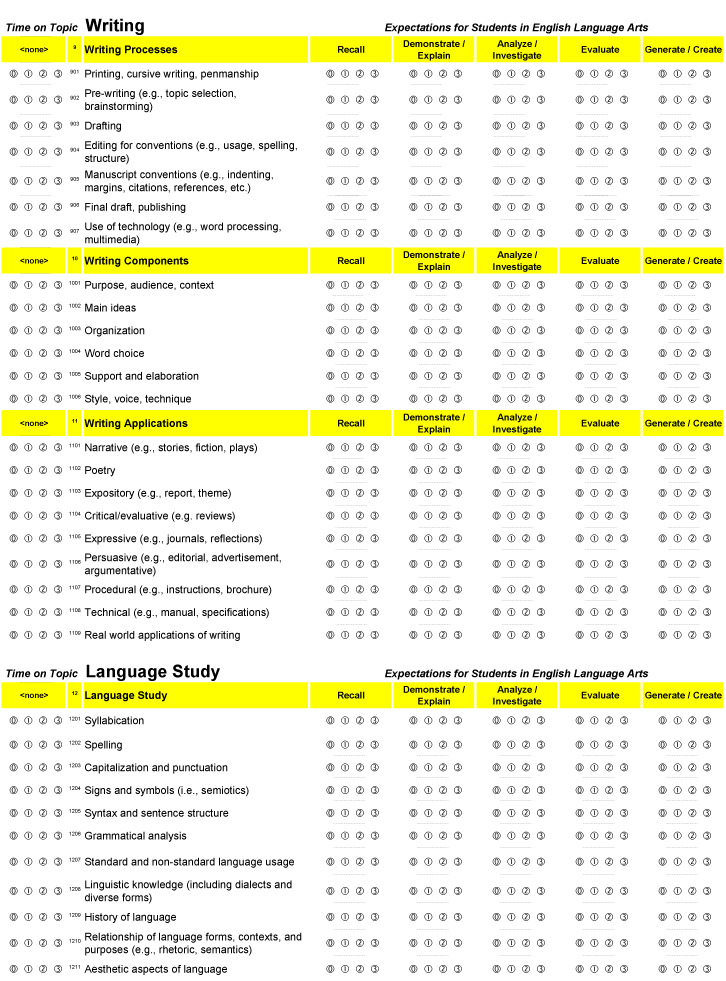

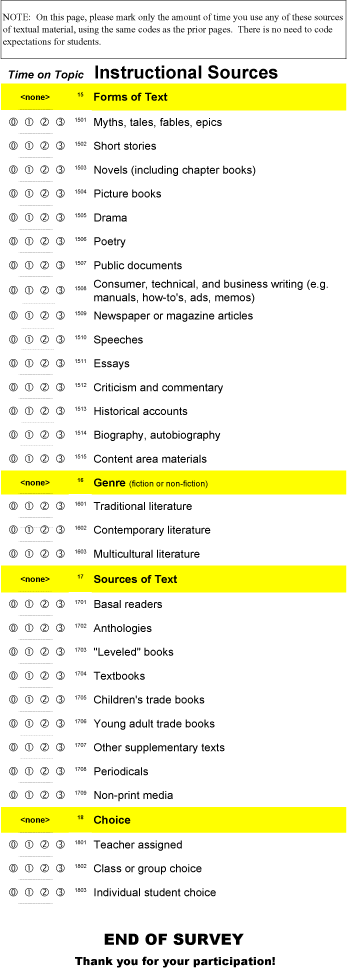
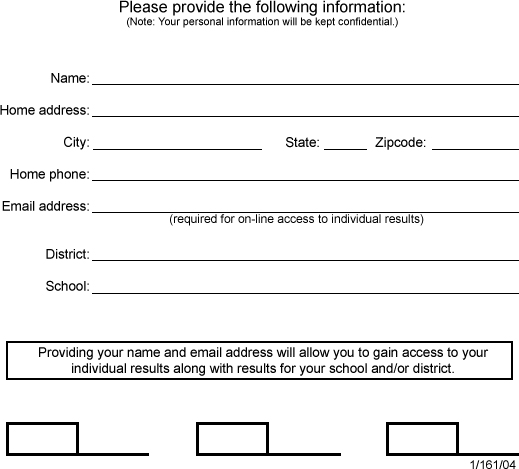
|
 |


